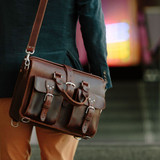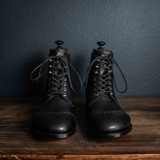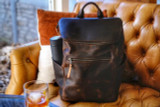Education to Choose the Right Reusable Isolation Gowns Wisely
“We ordered 15 gowns and recently ordered 10 more. The gowns are well made with a durable material that I feel safe wearing and proud to share with patients…”
Dr. Emily Harding
Owner and Dentist - Ivy Dental in Charlottesville, VA
We manufacture quality reusable water repellent FDA and CDC compliant isolation gowns and head covers and have them on our Texas shelves ready to ship today. Manufactured in our own FDA registered facility in Mexico, they are the most comfortable, environmentally friendly and healthy reusable isolation gowns in perhaps the world. Our factory, OMM, also manufactures AAMI Certified disposable isolation gowns for various large clients. Contact [email protected] to find out about us manufacturing directly for you or your client.
Saddleback Leather, is a U.S. leather goods company that designs and manufactures the longest lasting most durable cool leather briefcases, backpacks and duffle bags in the world. We're REALLY good at sewing leather. But when we heard our Texas governor's “call to arms”, we changed our leather factory over to being a manufacturer of much needed Personal Protective Equipment(PPE’s), Our goal is to now design and manufacture the most comfortable and longest lasting reusable PPE’s in the world. We own our factory in Central Mexico, Old Mexico Manufacturing (OMM), and we love our people. Check out my wife and I explaining our factory in this video here.
Which Isolation Gown to Choose
The U.S. Department of Health and Human Services, writes of the 3 types of isolation gowns to choose from, depending on your situation. They write, “...whether a gown OR apron is selected for PPE, or, if a gown is selected, whether it needs to be FLUID RESISTANT, FLUID PROOF, or NEITHER.” If you’re on the deck of a ship in a hurricane, wear a cotton jacket coated in wax. If you’re hiking on a rainy day, wear that jacket washed in a water repellent. And if you're walking in a windy desert, just wear that same jacket dry to keep the dust off. Virus microbes and dust particles floating in the air do not land on fabric and soak through like liquids do. AAMI guidelines, explained below, are mainly about fluid repellency of the isolation gown so dangerous bodily fluids do not soak through the fabric or seams. AAMI certification does not pertain to keeping floating particulates off of the wearer and therefore are not required by the FDA for non-surgical uses.
We have two isolation gown options on our shelves in Texas and one for pre-order:
-
Water Repellent Gown - In stock: Our best seller. With an easy side tie and comfy cotton/polyester protective knit cuffs for gloves to fit over. Water rolls off this Durable Water Repellent (DWR) coated gown like water off a duck’s back. For when there is a chance of pathogenic bodily fluids hitting the gown.
-
Hypoallergenic Dry Gown - In stock: Our second best seller. These isolation gowns are for those with sensitive skin, skin allergies or who are pregnant and shouldn’t wear polyester. With elastic inside the cotton wrist and no DWR coating. For when no bodily fluids are expected.
-
AAMI Certified Level 2 Gown - Pre-order: Used when spraying of pathogenic bodily fluids are possible, but overkill when used for dry situations. It is a handsome twill weave AAMI Certified Level 2 Reusable isolation gown with a pre-order for larger quantities.
Our Clients
We have sold hundreds of thousands of gowns to the Veteran’s Administration, Department of Homeland Security, multiple States and various public and private hospital systems. We sell mostly to hospitals, non-trauma medical facilities, dental clinics, prisons, nursing homes, home health care workers and rehabilitation professionals. Protect your front line staff with our water repellent, breathable and hypoallergenic isolation gowns.
Please Buy Domestically Made Isolation Gowns and PPE
To learn why nobody can compete with China’s low prices, click here. The New York Times reports the Uighurs slave labor is being used to manufacture PPE in China and CBS reports that last January, China spent billions of dollars buying up all of the PPE’s from around the world and then price gouged by selling them back at ridiculous prices. The Chinese people are beautiful, but the Communist Chinese government is awful. And now the Chinese isolation gowns have now flooded the US market. Watch this video of French nurses and their cheap Chinese gowns. Saddleback Leather had a problem about 10 years ago the only time we bought hardware from China that was too soft and fell apart. Their "certified scientific laboratory" report was fake. Check out this other CBS report on Surgical Gowns from China. Never again will we risk buying anything for Saddleback Leather from China. Watch this European Union news story about all of the fake certificate and unprotective PPE they are handling. By the way, good luck suing or trying to get any refund out of China. Resist the urge to chase low price and instant convenience while sacrificing long lasting quality or protection. Buy nice or buy twice and buy from North America to help build our economy back up.
If your neighbor has stickers and weeds in their yard, then you'll probably get them too. If their yard is healthy, yours will be healthier too. So, please consider buying goods made by your neighbors n Canada, the U.S. and Mexico if it is an option. If there were ever a time to lift your neighbor up, that time is now. Your neighbors need the work. And if you support them now then they'll more easily be able to support your company with the goods and services it offers too.
You can buy our gowns here. Contact us at [email protected] and we'll get right with you with lower prices and shipping rates. We're not just saying to only buy our PPE. There are a lot of good quality gown manufacturers out there. We are just asking that you consider not buying them from China.
Negatives of the 3 Types of Isolation Gowns on the Market
Thousands of hospitals, clinics and even entire states have moved to reusable isolation gowns and away from disposable isolation gowns since they are equally as protective, but far cheaper to own and not horrible
Disposable Spunbond Polypropylene is a petroleum plastic - Engineered to feel like a natural material, it costs about $0.58/lb. legally incinerate because it is “Medical Waste”. If isolation gowns are illegally thrown into the trash, they take up to 200 years to decompose. You can buy one of our $15 reusable gowns to use 60 times (Volume pricing available) or you can buy 60 $5 disposable gowns to use 1 time each (usually from China). A large 2018 study shows disposable isolation gowns were 50% to 100%, after washing and storage, more expensive to own than reusable isolation gowns, but even more costly today. The gasses and pollution, even though partially filtered when burned, are terrible to humans and the environment.
Reusable Polyester is a petroleum plastic - Read the reports and studies from Forbes, the EPA, National Institute of Health, Wikipedia etc. that Polyester can cause miscarriages, infertility, skin problems, headaches and fatigue if regularly worn against the skin. Many warn to keep babies away from it. Named “One of the most polluting fabrics on Earth” because of the hundreds of thousands of microplastics that wash off to the sea. Polyester is too expensive to recycle and when thrown away, takes up to 200 years to decompose. It doesn’t breathe well and so gets clammy warm. It is very cheap to manufacture and is a “filler” thread to cheap fabric just as saw dust is in cheap dog food or corn syrup is in cheap honey. It looks like cotton, but it isn’t. Microfiber is a mix of Polyester and Nylon.
Reusable Cotton Gowns - This is the only isolation gown we offer. Cotton is more expensive, requires a lot of water to grow, cotton garments shrink up to 4% and wrinkle if left in the dryer. Can be warm if worn over thick clothing. All high end hotels only use 100% cotton bedding so the body can regulate its temperature for better sleep. Cheap motels use Cotton/Polyester blend bedding and that’s why you don’t sleep well there. Cotton isolation gowns are very common throughout Europe.
FDA Classifications for Isolation Gowns and AAMI Levels 1,2,3,4 Explained
FDA Classifications and Certifications
Class I or Class II - The FDA classifies PPE’s as either Class I or Class II depending on whether people can be hurt with it or not if manufactured poorly or with materials that could hurt the body.
Class I PPE’s including all shoe/boot covers, head covers, face shields, scrubs etc. are technically called “Non-Medical Devices” by the FDA. Class I isolation gowns are called Isolation or Cover gowns and are “exempt” from FDA regulations. As per the FDA, “The basic requirement for isolation gowns (Class i) is that the manufacturer meets general standards for good manufacturing processes. Requirements regarding the use of PPE in the healthcare are overseen by the OSHA along with state and local agencies and employers. There are no mandatory standards that drive device selection and use, and certification is not mandatory either.” All AAMI certified Level 1 and 2 gowns are also Class I isolation gowns. We manufacture isolation gowns in our FDA Registered facility.
Class II is any PPE that can negatively affect the HCW or patient if not manufactured according to spec or stored correctly i.e. tongue depressors, scalpels, plastic tubes etc. They are technically called “Medical Devices” and are regulated by the FDA. If the Class II PPE is a gown, it is called a “Surgical” gown. They must be manufactured in a sterile FDA Certified facility and must pass AAMI and ASTM Level 3 or 4 test standards to be used in a restricted or semi-restricted surgical area. They are designed with extra protective materials and seams to protect the HCW. They are lint free and hermetically sealed to protect the patient from Surgical Site Infections (SSI). Read the recent Wall Street Journal story of 1300 bogus Chinese “Medical Suppliers” busted for fraudulently claiming FDA Certification. Be careful. We have seen Chinese “FDA Certified” fraudulent gowns sold out of Pakistan too.
AAMI 1,2,3 and 4 Certifications
Advancement of Medical Instrumentation AAMI and ASTM Standards were established in 2004 to assess liquid barrier effectiveness.
AAMI or ASTM quality tests for flame retardance, fabric tensile strength, seam strength, stiffness, breathability, water repellency etc. to determine if the gown is a Level 1,2,3 or 4. These test standards provide helpful guidance for HCW’s to understand which gown to choose for the situation, but are not required. The FDA requires adherence to Level 3 and 4 test standards for gowns used if there is potential for bodily fluids containing Ebola, Hepatitis, HIV etc. and the patient or HCW’s health is at risk of infection.
AAMI Level 1 Isolation Gowns - Very Low Risk for Water Penetration. For COVID-19, hurt backs, influenza, headaches, broken bones and other situations where you’re not expecting much bodily liquids. They keep virus droplets floating in the air from landing on your skin and clothes. Level 1 isolation gowns resist water from splashing right onto the skin, but the water or fluid will eventually soak in if it is a large amount. They do not repel, just resist pretty good.
AAMI Level 2 Isolation Gowns - Low Risk for Water Penetration. Pretty much the same as Level 1, but a little more water repellent because they’re a little thicker or a little denser. These medical isolation gowns are good if you are helping someone who just ate 12 bad oysters, you’ll want the peace of mind of a Level 2.
AAMI Level 3 Surgical Gowns - Medium Risk for Fluid Penetration. These surgical gowns protect medical staff by repelling bodily fluids with extra special fabrics on the front and arms and protect the patient from getting lint or anything into their wound or incision. Level 3 surgical isolation gowns come hermetically sealed sterile. These can be autoclaved.
AAMI Level 4 Surgical Gowns - Medium Risk for Fluid and Viral Penetration. Hermetically sealed and manufactured in a sterile FDA Approved facility. Special seam tape to stop viral penetration with bodily fluids with Hepatitis, HIV, Ebola etc. Can zip up like a bunny suit and is used for deadly Ebola virus patients and investigating alien crash sites. They are oftentimes seen with a forced air PAPR respirator breathing system attached. These can also be autoclaved.
Details of our Isolation Gowns:
-
Material: 100% Biodegradable Compostable Cotton. The fabric weight and tightness of weave is protective against virus penetration, not necessarily bodily fluid.
-
Sizes: One size fits most. We will have two sizes hopefully by July. One size fits all for big and one size fits all for little.
-
Reusable: Washable and reusable about 60 times or as much as a set of sheets or a good t-shirt would be.
-
Country of Origin: The beautiful region of Central Mexico
-
Registrations: Old Mexico Manufacturing is registered with the FDA, U.S. Department of Homeland Security’s CTPAT program. It is also registered with the Mexican government’s program IMMEX as a Maquiladora (foreign owned factory for the purpose of exporting out of Mexico).
Old Mexico Manufacturing: Our factory has been manufacturing in the same place since 2008, manufacturing for Saddleback Leather as well as for several other American companies. We have roughly 450 employees working on the manufacture of PPE’s.
Disclaimer: This message is for frivolous lawsuit people. Did you know it is wrong to lie and wrong to do what you do. If you do this, then you are considered a bad person. You can stop now and change who you are. Start your new life today. This gown is designed as a solution to assist medical personnel responding to the COVID-19 pandemic and provides some level of protection. But it will not keep you from getting sick. The design and materials make it, according to the FDA, technically a Non-Medical Device Class 1 Non-Surgical isolation gown which is exempt from regulation by the FDA, CDC or any other regulatory body. Use at your own risk. But if you were my mother, and in the medical field, I would insist you wear one of our isolation gowns to help keep the virus off of your skin and clothes and greatly lower your chances of becoming ill.
Kissing on a date: Water Resistant versus Water Repellent? Which isolation gown is right for working with COVID-19 patients?
Let's say a guy and girl go on a first date and right away the guy tries to kiss her. She is RESISTANT and says, "Listen here Buck-o, I'm not that kind of girl". But they get along really well and before long she gives in and kisses him. If she is REPELLENT then when he tries to kiss her, she REPELS him by kicking him where it counts and shoving her thumb into his eye socket. He runs off and has officially been repelled. Level 1 and 2 non-surgical isolation gowns are supposed to resist by not letting it blast right through the fabric, but eventually give in. Level 3 and 4 Surgical Medical isolation gowns repel the water and it runs off screaming. For COVID-19 workers, the CDC has told them to move to regular isolation gowns like the ones we're manufacturing. And here's why.
An OSHA instructor said that this is a good way to explain it. If you're wearing a tightly woven fabric shirt in a light rain, the drops may soak in and get you wet eventually, but you're not going to feel the raindrops hit your skin directly. Tightly woven Cotton or Polyester fabric is water resistant. If you're wearing an airy loosely woven linen shirt, then you will feel the raindrops hit your skin directly. It's the same with a cloth isolation gown. If someone coughs or sneezes on you, then you don't want to feel it on your skin or have the microbes casually float through one of the gaps in a loose weave. Remember, the goal of the gown is to protect people from getting the virus on their skin and clothing. Don’t get a thin one.
- Water resistant cotton/polyester isolation gown - If they are going to stay dry, but don’t want virus droplets getting on their clothes, then they only need a cotton or cotton/polyester isolation gown. If the wearer is going to be exposed to Coronavirus patients or someone with a hurt back, then they don’t need a water repellant gown because the virus microbes are passive and just float around, only moved by air movement. They don’t land on a gown and start burrowing through to the person.
- Water repellant medical isolation gown - If they’re going to be helping someone who ate a dozen bad oysters, then a water repellent medical surgical gown is the one you want. If they might get bodily fluids like blood, puss, vomit, saliva, snot, urine or poop on them, then they’ll need a water repellent Medical gown. No one wants it to soak through their gown and get onto their clothes or skin.
A hazardous materials expert in our city said their fireman suits are made with a water repellent technical synthetic fabric, but they still have to treat it every 10 washes to keep it water repellent. The normal cotton or cotton/polyester clean isolation gown is used around the world for the purposes like the COVID-19 Coronavirus, are not water repellent, as in, fluids don’t bead up and roll off, because the CDC and FDA don’t require they are. Of course, the typical cotton or cotton/polyester blend is water resistant like jeans are against light mists and light rain. The Indiolino cotton fabric technical specs. The benefits of reusable medical isolation gowns over disposable.
- For your emergency disaster reserve. Because of the switch to disposable from washable reusable isolation gowns, very few have an emergency reserve in the U.S.
- Disposable Gowns have a horrible shelf life. Use them fast because they fall apart and are worthless in a short time. They're an inventory nightmare to store.
-
Cloth isolation gowns are long-lasting. The COVID-19 is not going away anytime soon. The CDC even recommends in times like this that if you get a tear in them, to patch it.
-
Less expensive to own. A study by Environmental Clarity Inc. found reusable isolation gowns reduce costs as much as 25 to 50 percent. Buy 60 disposables or 1 reusable.
-
More efficient employees. Hospitals who committed to reusables earlier are not short on supplies and their employees are working on important matters instead of searching for next month's supply.
-
Environmentally Great. Disposable medical gowns do not decompose in landfills. Some incredible Spunbond Polypropylene disposable trash isolation gowns salesman sold healthcare providers to throw away stadiums full of isolation gowns into landfills yearly. Only a few VERY wealthy people will ever know how that happened.
- 30% lower greenhouse gas emissions
- 28% lower consumption of natural resource
- 41% lower water consumed that is not returned to the source
- 93% to 99% lower solid waste at healthcare facilities
-
Everybody's doing it. Europe and most of the rest of the world primarily uses biodegradable cotton, cotton/polyester or polyester gowns like ours.

In their wisdom, The Center for Disease Control and Prevention (CDC) knew that if all we have are disposable isolation gowns and our supply chain were cut off, like it is now, it would be disastrous. And they were right. Therefore, the CDC gave all health care and government agencies the following strategies to execute on during “Contingency” and “Crisis Capacities”.
Concerning isolation gowns in the Contingency Capacity (we are beyond that and in the Crisis Capacity), the CDC tells all health care providers to “Selectively cancel elective and non-urgent procedures and appointments for which a gown is typically used by HCP”. Then, “ Shift gown use towards cloth isolation gowns. Reusable (i.e., washable) gowns are typically made of polyester or polyester-cotton fabrics. Gowns made of these fabrics can be safely laundered according to routine procedures and reused.” And this is why we’re manufacturing PPE’s exactly like the ones The CDC, FDA and The National Institute of Health suggest everyone use.
Our Reusable Cloth Face Masks are the exact washable cloth mask that the CDC has on their website that they recommend for the general public to wear. They are not as good as the medical N95 or surgical masks, but they are double layered cotton and good for stopping a lot of the transmission of the Coronavirus. An ER doctor just told me that they use homemade masks like this over the top of their really good masks so they don’t go through the good ones so quickly. He said it’s easier to wash a cloth one than find a medical one. But again, the CDC says that this will not keep you from getting sick, but it will help others to not get sick by you.
Learn the basics of fabric so you don’t get took with a cheap loosely woven fabric. One square yard of our fabric weighs 5.2 oz. therefore it is 5.2 oz fabric or 175 grams per sq. meter. It's a tightly woven material developed to resist water. Be careful if someone offers you a reusable isolation gown that is a lesser weight fabric than that. It generally means that the fabric is not as tightly woven (or doesn't have as many threads per square inch and therefore has a whole lot more little gaps between the threads. And remember, some of the fibers of the thread fall off with each wash and dry cycle to make it even less protective. Every inch of our fabric has 62 threads going longways (warp) and 40 threads going left to right (weft). That's why it weighs so much. Saddleback Leather's Scottish canvas bags are made with a 24 oz cotton fabric. To learn more why canvas is a far superior reusable material to nylon or others, check out here why natural cotton canvas tents, like our gowns, are the best for camping in wet weather

In this article from the National Center for Biotechnology Information (NCBI) and the National Institute of Health (NIH), they talk about the accepted and current use of reusable cotton isolation gowns throughout all of Europe and the rest of the world.
The hospitals in other countries and the ones who already using reusable cloth isolation gowns in the USA, aren't desperate right now because they just wash theirs and use them again. Why wouldn’t the Federal Government have a giant reserve in the Strategic National Stockpiles of cotton or polyester/cotton isolation gowns like the CDC insists needs to happen in emergencies? It seems that you’d want to have medical equipment that has a long shelf life instead of the short shelf life disposable Spunbond Polypropylene trash.
We reached out to the FDA to register to be under their regulations and their response is that it was unnecessary because gowns like ours are not regulated by the FDA. Their email is below.

The following is from the CDC’s website
Strategies for Optimizing the Supply of Isolation Gowns
Crisis Capacity Strategies
Cancel all elective and non-urgent procedures and appointments for which a gown is typically used by HCP.
Extended use of isolation gowns.
Consideration can be made to extend the use of isolation gowns (disposable or cloth) such that the same gown is worn by the same HCP when interacting with more than one patient known to be infected with the same infectious disease when these patients housed in the same location (i.e., COVID-19 patients residing in an isolation cohort). This can be considered only if there are no additional co-infectious diagnoses transmitted by contact (such as Clostridioides difficile) among patients. If the gown becomes visibly soiled, it must be removed and discarded as per usual practices.
Re-use of cloth isolation gowns.
Disposable gowns are not typically amenable to being doffed and re-used because the ties and fasteners typically break during doffing. Cloth isolation gowns could potentially be untied and retied and could be considered for re-use without laundering in between.
In a situation where the gown is being used as part of standard precautions to protect HCP from a splash, the risk of re-using a non-visibly soiled cloth isolation gown may be lower. However, for care of patients with suspected or confirmed COVID-19, HCP risk from re-use of cloth isolation gowns without laundering among (1) single HCP caring for multiple patients using one gown or (2) among multiple HCP sharing one gown is unclear. The goal of this strategy is to minimize exposures to HCP and not necessarily prevent transmission between patients. Any gown that becomes visibly soiled during patient care should be disposed of and cleaned.
Prioritize gowns.
Gowns should be prioritized for the following activities:
- During care activities where splashes and sprays are anticipated, which typically includes aerosol-generating procedures
- During the following high-contact patient care activities that provide opportunities for transfer of pathogens to the hands and clothing of healthcare providers, such as:
- Dressing, bathing/showering, transferring, providing hygiene, changing linens, changing briefs or assisting with toileting, device care or use, wound care
Surgical gowns should be prioritized for surgical and other sterile procedures. Facilities may consider suspending the use of gowns for endemic multidrug-resistant organisms (e.g., MRSA, VRE, ESBL-producing organisms).
For more information on pricing and availability and deliveries, please email
Tech Drawings and Photos
The following drawings we made are of the isolation gown we are proposing and the pictures that follow are pictures of the actual prototypes that we produced at our factory in Mexico. I received them at our warehouse in Fort Worth, Texas March 30th, 2020. The people in the pictures are 5’3”, 5’10” and 6’2”.









